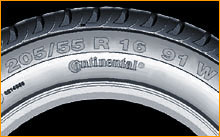
Below are explanations of the specifications imprinted on the tyre side wall.
‘P’ is the Tyre Class. The tyre is a passenger car tyre. If the Tyre Class is ‘LT’, it is a light truck tyre.
‘205’ is the Section Width of the tyre. It is measured in millimetres (mm) from sidewall to sidewall. Foe example, the section width of this tyre is 205 mm.
‘55’ is the Aspect Ratio of the tyre. It is a comparison of the tyre sidewall height and the section width. For example, 55% of 205 mm is 112.75 mm. Thus, the height of the tyre sidewall is 112.75 mm.
‘R’ indicates the Tyre Construction. ‘R’ means the tyre is of radial construction. Other examples are ‘B’ which is belted bias construction, and ‘D’ which is diagonal bias construction.
‘16’ is the Wheel diameter. It is measured in inches. For example, the diameter of this wheel is 16 inches (approxmately 406 mm).
‘91’ is the Load Index. Load Index is the maximum weight the tyre can withstand when properly inflated. Ranging from 75 to 105 for passenger tyres, the maximum weight capacity of the tyres can be derived through a Load Index chart based on the Load Index number.
‘W’ is the Speed Rating of the tyre. It shows the maximum speed the tyre can withstand at its ideal load capacity. For example, ‘W’ can reach a maximum speed of 270 km/h. It is to be noted that Goh Swee Hin encourages drivers to follow the speed limits regardless of tyre speed ratings.